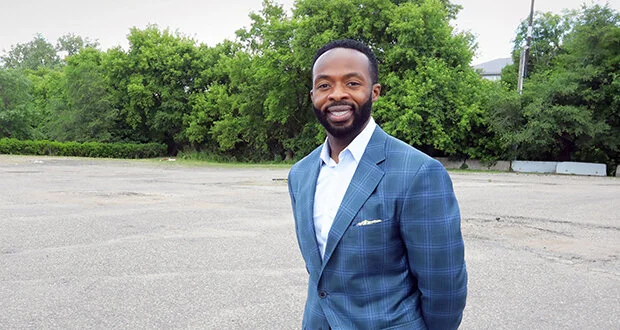Gaining a Foothold
[Originally Published On Finance & Commerce, Written By Brian Johnson: View Source.]
As a Twin Cities architect with 30 years of experience, Alicia Belton has strong ties to the local building industry — and a truckload of connections to builders, developers, suppliers and specialty contractors.
But when it comes to finding a Black-owned business to bid on a project, or even do a plumbing or electrical job in her own home, Belton is hard-pressed to find someone in an industry still dominated by white males.
“I am in this industry, so people ask me all the time, do you know a Black plumber, do you know a Black electrician?” said Belton, owner of Urban Design Perspectives in Minneapolis. “They all work for somebody else. Or they don’t do residential, they do commercial.”
For the most part, she says, the same is true of developers.
“I would say most of the developers that I know are all white men,” Belton said. “I think what’s happening now is that clients are asking for a more diverse project team. So you’ll see individuals on the team, but you know they’re not the ones that are leading the project.”
Specific data is hard to come by, but recent research and anecdotal evidence support Belton’s observations that the Twin Cities construction and development community is still largely the domain of white-owned businesses.
Johnny Opara, a Twin Cities-based developer of color, estimates that less than 1% of all developers in the metro area are Black.
Johnny Opara, president and CEO of JO Companies LLC, at the site of his first development called The Hollows, at 520 Payne Ave. in St. Paul. Photo: Bill Klotz
“When you don’t have folks that look like you in this space, the barriers to entry are so high it de-motivates you to continue on this path,” Opara said. “Or if you’re already on this path, the stress alone, the uncertainty alone, would have you thinking, ‘Am I doing what I’m supposed to be doing?’”
Opara’s experience is consistent with the findings of a recent report conducted by Minnesota-based JOG Associates. The report finds that white males “dominate the real estate development industry” and that white business networks “tend to exclude” developers of color.
Inequity in homeownership, such as discriminatory redlining policies, is part of the problem, experts say. In Minnesota, the homeownership gap between white households and people of color is the fourth-largest in the nation, according to a recent report from the Minneapolis Fed.
But other factors are at play as well.
Developers of color tend to have less personal wealth and fewer business connections than established developers, their projects are viewed as “too risky,” and they’re often “directed” to team up with more experienced developers to get approval for their projects, according to the JOG Associates report.
LISC Twin Cities, a local nonprofit that promotes investment in historically low-income neighborhoods, commissioned JOG Associates to do the report, which is based on interviews and focus group sessions with dozens of developers, including people of color. The report also draws on surveys and data from more than 50 government, nonprofit, and philanthropic stakeholders.
Somali-born Nawal Noor, founder of Noor Cos., told Finance & Commerce in a 2020 interview that accumulating capital, attaining bonding ability, and establishing networking relations are among the biggest challenges for an emerging business.
“You have to have a certain level of capital to be able to bond” for public construction projects, Noor said. “For small, minority-owned businesses it’s hard to find that capital; you have to build that capacity over time.”
Peter McLaughlin, executive director of LISC Twin Cities and a former Hennepin County commissioner, said the development process is “pretty long and torturous,” especially for developers of color.
“If you’re a new developer of color, the guardrails that other people have as they’re making their way down this path — they’re just not there,” McLaughlin said.
Inspired by his father
One emerging developer trying to get a foothold on that path is Nigeria-born Johnny Opara, CEO of JO Companies, a Twin Cities-based development company specializing in workforce housing projects.
A graduate of St. Paul Central High School and Augsburg University, Opara is a licensed Realtor. After a long run in the corporate world, he was inspired to get into the development business after the death of his father, who had limited income and was forced to live in subpar housing toward the end of his life.
“My father was the main reason I got into this,” Opara said. “I made him a promise that I would finish what I started, which is this [St. Paul] project.”
Making good on that promise, Opara hopes to begin construction later this year on two workforce housing projects in the Twin Cities: a 54-unit development at 520 Payne Ave. in St. Paul, and a similar-sized project at 61st Avenue and Brooklyn Boulevard in Brooklyn Center.
“We just want to … reinforce the importance of housing and how that is the foundation for families and for individuals who are looking to grow in an environment that’s going to benefit them in the long-term,” Opara said.
Creating that environment isn’t easy.
As an up-and-coming developer of color, Opara said the biggest challenges he has faced have been acquiring the resources to get his projects off the ground, and gaining the confidence of cautious investors.
“At the end of the day when you haven’t done a multifamily development, and you haven’t gone through construction before, [the investors] are thinking to themselves, well, ‘Hey, how are you going to do this?”
Opara says he’s not doing the work in a vacuum. His support network includes LISC Twin Cities, veteran developer Rich Pakonen, officials from the city of St. Paul and Brooklyn Center, among others.
“These organizations and these individuals, who really believe in me, have allowed me to navigate these challenges, whereas others who didn’t have a support system may have given up,” Opara said.
A new way of doing things
For his part, Minneapolis-based NEW RULES founder Chris Webley specializes in transforming unproductive buildings in underserved communities into vibrant spaces of innovation.
The business took a big step toward achieving that vision in 2015, when it acquired a historic commercial building at 2015 Lowry Ave. N. in Minneapolis. NEW RULES restored the building with “5,000 hours of sweat equity” and nearly $200,000 in personal savings, its website notes.
Since it opened in October 2016, the NEW RULES on Lowry building has offered shared workspace, event and multipurpose space, gatherings for artists and creators, and business and creative services on the north side.
Among Webley’s current projects is the renovation of Bell Lofts, a 25-unit affordable housing development in at 816 21st Ave. N. in Minneapolis. Webley acquired the building in March. Built in 1916, Bell Lofts is so-named because it once was a home for the Bell Telephone Co.
Webley did his first multifamily housing project, a modest rehab, in Columbus, Ohio. In 2012, a job with Target Corp. brought him to the Twin Cities, and he has been investing in the community ever since.
What are the biggest barriers to success for developers of color?
“The biggest thing that we all lack is access to resources and financial capital to do these types of projects,” Webley said.
“We all, I think, want to be in Black and Brown neighborhoods. But if you’re on the North Side, and you’re thinking of new construction, it starts out 50% underwater from the day you conceive it. Right off the bat, money is an issue,” he added.
“And so oftentimes, Black people like myself are having to go to other folks who don’t look like me with my hand out asking for something which puts us in a vulnerable situation where I need to play by your rules,” he added.
Efforts to increase diversity
Hoping to move the needle on diversity, LISC Twin Cities recently launched its “Developers of Color Building Initiative.” Part of the idea is to encourage investment in historically low-income neighborhoods. To that end, the new initiative aims to help developers of color get across the finish line with their residential, commercial or mixed-use projects in the Twin Cities.
Opara and Webley are among the 12 developers selected to participate in the first-ever initiative. The selected developers are working on projects ranging from small commercial or residential projects to high-density developments, some of which are in the areas where last year’s civil unrest took place.
The participants emerged from a field of 41 applicants. LISC Twin Cities hopes to select another round of developers later as more funding becomes available.
McLaughlin said the initiative will “further the effort toward transformational change to disrupt systemic racism and drive more social capital and ownership in low-income neighborhoods and communities of color.”
The Associated General Contractors of Minnesota, a 100-plus-year-old organization that serves the construction industry in Minnesota, is taking steps of its own to promote diversity. Among those is the addition of a diversity and equity specialist to the organization’s staff.
AGC’s strategic plan includes a “diversity, equity and inclusion” program with a leadership council made up of BIPOC members. AGC is also working on an “at-large” committee where members can collaborate with BIPOC firms and share best practices.
“We have intentionally extended invitations for our BIPOC firms to actively participate and engage with us,” said Yolanda McIntosh, director of diversity, equity and inclusion for the AGC of Minnesota.
The Twin Cities’ development community has seen some success stories.
Among those is Minneapolis-based Noor Cos., a minority woman-owned general contractor and developer. Noor Cos. has delivered a number of projects for owners ranging from Target Corp. and US Bank to the city of Minneapolis and Hennepin County.
Minnesota is also home to Shaw-Lundquist, a Top 20 general contractor in the Twin Cities area and an Asian American-owned business with national prominence. President and CEO Hoyt Hsiao said in a 2019 interview that the company has done projects in excess of $75 million.
Even so, the JOG Associates report suggests that the Twin Cities has a long ways to go.
In a nutshell, the report says, developers of color still demonstrate “evidence of trauma that stems from systemic racism in real estate, racial discrimination in banking, modern-day redlining, and racial covenants.”
Webley’s company, for one, is trying to re-write that script.
As the company’s website puts it, NEW RULES is “a collective built on the idea of developing ecosystems & solutions for Black & Brown communities where economic, health & wellness and education disparities breed.”
“If you want marginal change, you do something marginally different,” Webley said. “If you want drastic change, you do something drastically different, which is pretty simple.”

